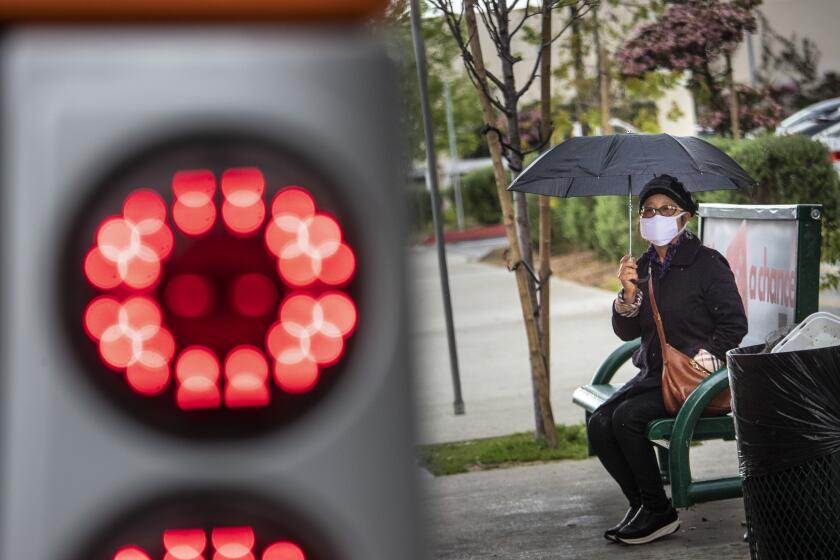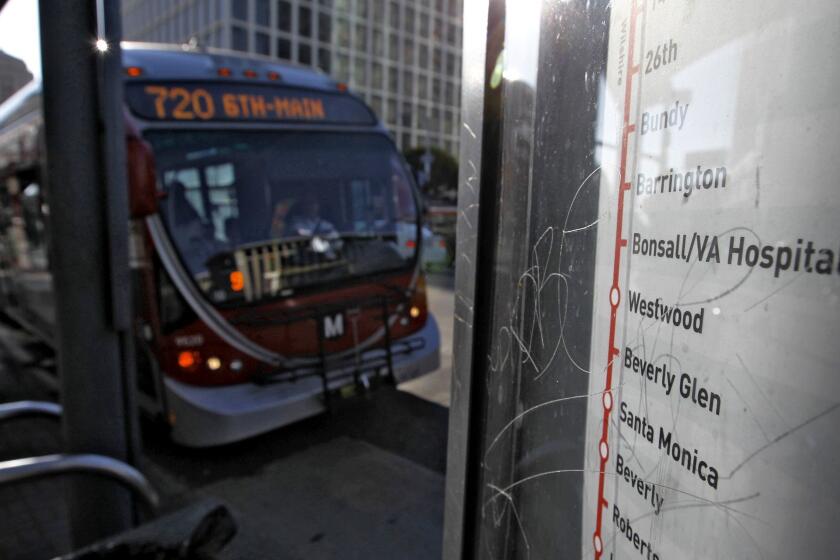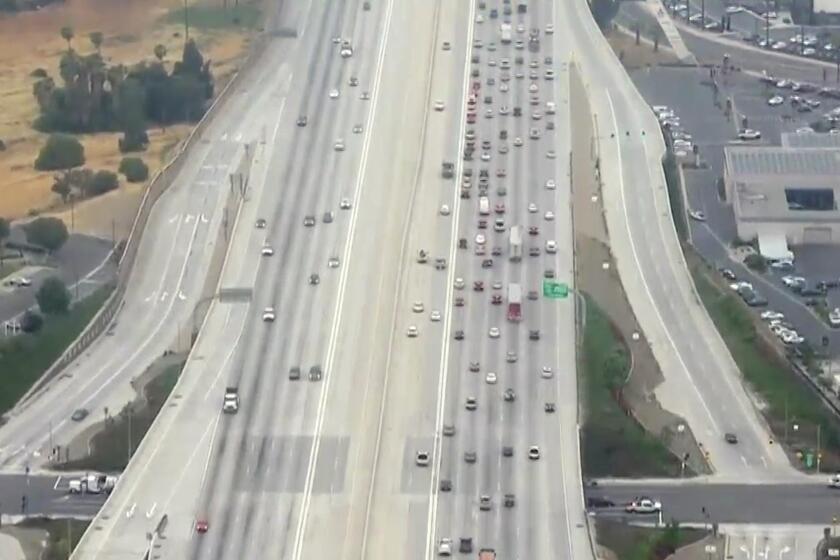Editorial: Los Angeles County bus riders get no shelter from the storm

- Share via
Woe to the person waiting for a bus in torrential rain or a heat wave. At the vast majority of stops across the region, bus riders will find no shelter from the storm or the blazing sun. Just 1 in 4 stops served by Los Angeles County Metropolitan Transportation Authority buses provide cover from the weather, according to a new analysis.
It’s a sign of how little thought or planning has gone toward improving conditions for bus riders in Los Angeles County, despite voters backing four sales tax increases since 1980 to pay for transportation projects and programs. More than 560,000 people ride Metro buses every day. What should be a simple, basic amenity of bus service — a bench to sit on and some shade while waiting — is still a rarity in most areas of the county.
But as climate change fuels more deadly heat waves, bus shelters will no longer be considered an amenity. They will be a necessity to keep riders safe. It’s time for Metro and cities across the region to cooperate on a plan to fund, build and maintain bus shelters at most stops.
Despite voters in Los Angeles pouring money into transit with sales tax increases, bus shelters are still in woefully short supply.
Until recently, Metro didn’t keep track of whether stops had benches or shelters. Metro operates the buses and chooses the stops, but cities, which control the sidewalks, are responsible for providing shelters and benches. There’s often little coordination between the agencies.
That’s slowly changing. Metro surveyed bus stops across its 1,000-square-mile service area with the goal of trying to get more state and federal funding for shelters. Metro provided the data to UCLA’s Lewis Center for Regional Policy Studies and MoveLA, a transit advocacy group, which examined and mapped 10,500 bus stops.
The analysis found that only 26% of stops have shelters. About half of stops have a bench, The Times reported last year. Most of the areas where bus stops are located have an average summer land surface temperature of more than 97 degrees. A shade structure can lower the temperature of surfaces by 25 to 40 degrees, according to MoveLA.
It’s time — again — to test whether Los Angeles’ political leaders have the mettle to build a transit-friendly, environmentally sustainable city.
If riders are lucky, there may be a tree nearby to provide shade, but the region also has a dearth of street trees, particularly in low-income communities of color. About 18% of Los Angeles County is covered by tree canopy, which is less than the national average of 27%.
There are also big differences in the prevalence of shelters across the region, the analysis found. Some cities have chosen to make shelters a priority. In Bell, 89% of stops have shelters (42 of the city’s 47 stops). Neighboring cities of Huntington Park, Bell Gardens and Maywood also provide bus shelters at more than 60% of stops.
But nearby Downey has shelters at only 8% of its stops (12 out of 143 stops). Beverly Hills has a shelter at just one of its 95 bus stops. (A 2021 Complete Streets plan from the city acknowledged the dismal situation, noting, “Improving bus stops will dramatically improve the transit rider experience in Beverly Hills.”)
The expansion of highways will do far more harm than the expansion of mass transit will avert.
The city of Los Angeles, which has the highest concentration of Metro bus lines, provides shelters at 23% of its bus stops. L.A. leaders have also recognized that is woefully inadequate. The City Council approved a new bus shelter contract last year with the goal of adding 3,000 shelters across the city, targeting stops with high ridership in hotter areas. The program is designed to provide shade for 75% of riders.
Under the agreement, the city pays for the upfront cost of installing the shelters and will receive 60% of the revenue from advertising, including digital ads, on the back end. Installation was expected to begin this summer, but city officials have yet to sign off on a $30-million loan to get the work started, which has some advocates worried that city bureaucracy could again slow the rollout of shelters.
That must not be allowed to happen. Los Angeles leaders have ambitious goals to increase transit usage and reduce driving to help fight climate change. The city will never meet those targets without making public transit — and buses are the workhouses of transit — more comfortable, reliable and safe.
It’s good that Metro and more cities in the area are beginning to plan and fund critical bus infrastructure. But this is a problem across California. Assemblymember Isaac Bryan (D-Los Angeles) has introduced Assembly Bill 364, which would require that transit agencies send to the Department of Transportation information on the availability of bus shelters and benches along their system, which would allow lawmakers and advocates to see which communities are failing to provide for riders.
For too long, bus stops have been an afterthought when they should be treated like the front door to public transit, one that welcomes riders and improves the surrounding community.
More to Read
A cure for the common opinion
Get thought-provoking perspectives with our weekly newsletter.
You may occasionally receive promotional content from the Los Angeles Times.













